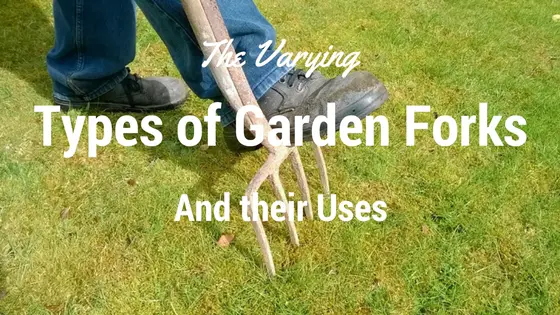 While there are many types of garden forks that you can have most people I know tend only to have one that they use for everything. Or if they have more they are of the same type. These are usually the garden fork.
While there are many types of garden forks that you can have most people I know tend only to have one that they use for everything. Or if they have more they are of the same type. These are usually the garden fork.
Or if they have more they are of the same type. These are usually the garden fork.
Knowing each type of fork and their uses will help you choose the best tool for you and for the job you want it for.
There are several types of forks for the garden. These include the garden and digging forks, the border, the potato and the pitch or compost forks.
Contents
The Varying Types of Forks for the Garden and What They Are Used For
Garden and Digging Forks The Main Fork To Have
Garden forks tend to be the main fork used in the UK. These usually have four tines or prongs. These are what most people use for most tasks in the garden. These are used for digging, turning and breaking up of the soil. They are great for parts of the country that have heavy clay like where I live. They are also often used instead of the other kinds of forks for lifting potatoes and turning of compost.
In the US they also have a digging fork which is a cleverly designed fork with wide flattish diamond shaped prongs to make digging easier.
Border Forks The Perfect Tool for Smaller Spaces or People
These are smaller versions of the garden fork. Again with four tines. They are simply lighter and narrower so are better suited to smaller feet as well as to borders. They are great for people who are smaller or find the full-sized fork too heavy and wearing to use. I use these because the full sized ones are too heavy and big for my small feet.
Some people may find they do not like the angle of their foot on the border fork and that it may slip off. Some also find that it is not strong enough for the tougher parts in gardening and that due to it’s smaller size it takes longer to dig over the ground.
My own view is that if you are a smaller person you may find you would soon get tired of wielding a larger too so there would be no advantage to it digging a larger space. The angle of my foot has never been a problem (size EU 38 feet) yet it would probably slip if you had larger feet.
Note: The top two options are where I would recommend you start and invest in the best quality you can get of either of these as these and the spades are what do the heaviest work. This will not only save money in the longer term but also make working easier and more enjoyable.
If budgets are tight, then go at least for a mid-range tool.
What to Look for in your Garden and Border Forks: You need strong tines that ideally are all from on piece of metal as this is stronger. Tine width does vary. You need a rust free or resistant metal. The tines should glide easily through the soil.
It should be lightweight and well balanced with a comfortable easy to grip handle. Shaft materials and length are a matter of personal choice. However, a well-made fork can last a lifetime and beyond if well looked after.
Explore different Border forks.
Lift Potatoes with a Potato Fork
There are all kinds and designs of potato forks. These are meant only for potato lifting and not to be used to dig because they have blunt ends to prevent you putting holes in the potatoes. Some have the same amount of tines as a normal fork however many also have more tines so the potatoes don’t fall through the gaps.
What to Look For in Your Potato Fork: More tines will mean you easily dig up more potatoes that you might otherwise have missed. You would also be better off with a slightly heavier steel as the fork is holding quite a lot of weight and needs to be able to lift the potatoes. You don’t want anything that is too heavy though as you are already lifting a reasonable weight. Also, heavier tines are less prone to damage.
Pitch or Compost Forks
These are usually used for hay and straw and also for turning your compost heap over. These are quite different in look from other forks. While they still have 4 tines they are long and slender. They are also usually curved to hold more compost. The tines are very sharp so they can stab the compost better.
What to look for in Your Compost Fork: Look for quality well balanced and strong designs with longer wide set tines that hold more.



